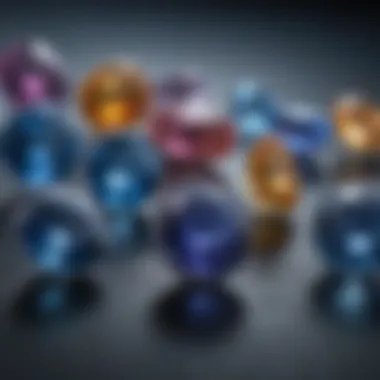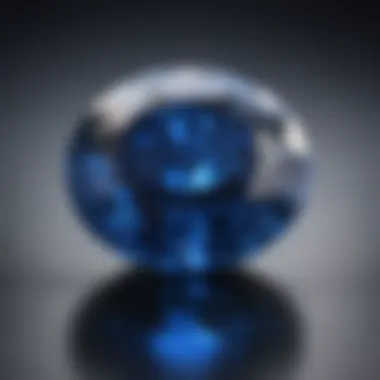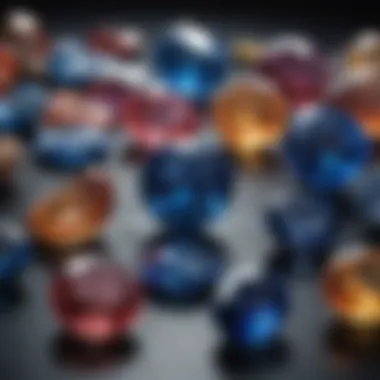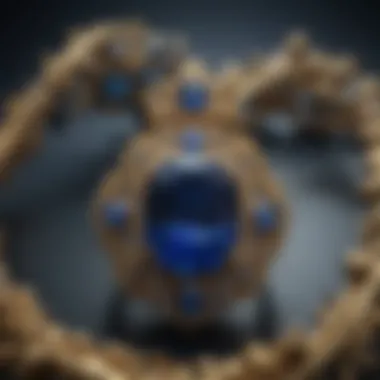Exploring the Visual Characteristics of Sapphire


Intro
Sapphires have been cherished for centuries, not only for their remarkable beauty but also for the rich stories they tell. Whether you are a seasoned collector or just dipping your toes into this captivating world, understanding the different aspects of sapphire is paramount. The allure of sapphires doesn’t merely lie in their stunning blue hue; these gemstones come in a variety of colors and each has its own unique characteristics. This guide ventures into the depths of sapphire’s visual charm, addressing its color spectrum, clarity, cut, and more. We’ll also explore the historical significance and the nuances between natural and synthetic sapphires, equipping you with the knowledge needed to make informed decisions in your collecting journey.
Color Spectrum of Sapphires
When it comes to sapphires, color is king. The most recognized sapphire, of course, is blue. This striking color, however, consists of many shades. There’s the deep royal blue that commands attention and lighter hues resembling a serene sky. Beyond blue, sapphires can showcase a dazzling array of colors known as "fancy sapphires." These include splendid pinks, vibrant yellows, and rare greens.
The Fascination with Color
- Blue Sapphires: Often sought for their classic beauty and symbolic meanings, these gemstones capture the imagination. The deeper the color, generally, the higher the value.
- Fancy Sapphires: These are a treasure in their own right. The rarity of certain colors, like orange or green, can translate to a premium in the market.
- Color Changing Sapphires: Some sapphires exhibit the remarkable ability to change color under different lighting, an effect that adds an extra layer of intrigue and appeal.
"The beauty of a sapphire is not just in its vivid color, but in the stories it whispers to its beholder."
Clarity and Cut
After color, clarity and cut emerge as key factors determining the overall appearance and value of sapphires. Clarity refers to the presence of internal or external flaws, often termed "inclusions" or "blemishes." Ideally, a sapphire should be clean to the naked eye. However, some inclusions can enhance the character of the stone.
The Role of Cut
The way a sapphire is cut significantly influences its brilliance and overall appeal. A well-cut sapphire not only captures light effectively but also showcases its color beautifully. Here are some popular cuts:
- Round Cut: Timeless and classic; this cut maximizes sparkle.
- Oval Cut: Offers elegance and a larger appearance.
- Emerald Cut: Provides a sophisticated look, showcasing the color and clarity effectively.
Natural vs. Synthetic Sapphires
Understanding the difference between natural and synthetic sapphires is crucial for any collector. Natural sapphires are formed in nature under unique geological conditions, while synthetic sapphires arelab-created replicas that mimic the physical and chemical properties of the natural stone.
Why it Matters
- Value: Natural sapphires generally hold more value than their synthetic counterparts, primarily because of their rarity.
- Collector Preferences: Many collectors prefer natural stones, valuing their history and authenticity.
Understanding Sapphire
Sapphire, often mistaken as merely a beautiful blue gemstone, has far more depth than meets the eye. Understanding sapphire is not just about identifying its hues or cut; it’s about grasping its multifaceted nature and the intricate details that contribute to its appeal among collectors and enthusiasts. This section delves into the very essence of sapphire, highlighting key elements such as its classification, geological origins, and the unique characteristics that enhance its allure in both jewelry and collections.
Definition and Classification of Sapphire
At its core, sapphire is a variety of the mineral corundum, which is primarily composed of aluminum oxide. While blue is the most recognized color, sapphires actually come in a spectrum of colors, collectively known as 'fancy sapphires.' These can include shades of yellow, green, pink, and even colorless varieties. The fundamental classification of sapphire revolves around these color variations.
In the jewelry industry, sapphires are often classified based on their color intensity and saturation. A rich, deep blue is typically deemed more valuable than lighter shades. Furthermore, the trade designations can be slightly intricate; for instance, pink sapphires are sometimes referred to as rubies if they exhibit enough red coloration. This subtlety in classification is crucial for collectors who are keen on identifying authentic pieces versus synthetic imitations or lesser-quality stones.
Geological Origins
Sapphire's geological roots are as fascinating as the gem itself. These gemstones generally form in metamorphic rocks created under high pressure and temperature conditions. Most often, sapphires are found within alluvial deposits—places where rivers and streams have washed away minerals from their original site, making gems accessible to collectors.
The leading sources of sapphire include regions such as Sri Lanka, Myanmar, and Madagascar. These locations not only contribute to the geographical diversity of sapphires but also introduce various environmental factors affecting their appearance. For example, heat and pressure within these environments can yield sapphires with unique inclusions that tell a story of their formation.
Geologists often reference sapphire's “origins” to infer not only where the gem has been mined but also the potential market value, rarity, and overall desirability in the eyes of collectors.
Sapphire’s geological origins are significant when considering its background and impact on collecting. The tale of a sapphire—where it hails from, how it was mined, and how it made its journey to the collector's shelf—adds layers of richness to the buying experience. This context is what many collectors treasure just as much as the gemstones themselves.
Visual Characteristics of Sapphire
When discussing gemstones, the visual characteristics of sapphire serve as a focal point for understanding its overall appeal. These traits, captured through color, clarity, and cut, are essential in distinguishing sapphires among precious stones. For enthusiasts and collectors, grasping these nuances not only enhances appreciation but also informs purchasing decisions. The unique blend of aesthetics and geology in sapphires invites deeper exploration of their visual characteristics.


Color Variations
Blue Sapphires
Blue sapphires are the most well-known and sought-after among all types of sapphires. Their vibrant blue hue, ranging from a light sky blue to a dark royal blue, is arguably their most defining feature. The deep saturation and brilliance of these gems make them a favorite in jewelry, particularly in engagement rings. What adds to their charm is the phenomenon of pleochroism, where the sapphire appears to change colors when viewed from different angles. This unique quality is often seen as a hallmark of a high-quality blue sapphire.
However, it's essential to note that the intensity of a blue sapphire's color can significantly impact its value. A sapphire that is too light might be deemed less desirable, while a very dark stone may obscure the inner details that contribute to its allure. Collectors and enthusiasts often prefer stones with a balance that allows for depth yet displays clarity.
Fancy Sapphires
Fancy sapphires, encompassing shades like pink, yellow, and even green, present a fascinating deviation from their blue counterparts. Each shade carries its unique appeal and cultural significance. For instance, pink sapphires have gained tremendous popularity due to their romantic association. Similarly, yellow sapphires can represent prosperity and wisdom.
The key characteristic of fancy sapphires is the vast spectrum of colors available, making them versatile for various jewelry designs and personal tastes. Their ability to catch light differently depending on the hue enhances their visual attraction. Some collectors find fancy sapphires to be beneficial choices because they often come at a more reasonable price than blue sapphires, allowing for more variety in collections.
Clarity and Transparency
Clarity and transparency are crucial in evaluating sapphires. Generally, the fewer inclusions a sapphire has, the more valuable and appealing it becomes. Inclusions are natural occurrences within the stone, which may affect its clarity and can sometimes detract from its beauty. However, in some cases, certain inclusions can actually add character to a sapphire, influencing its value and rarity in positive ways. Transparency plays a significant role in how light interacts with the gem, ultimately affecting its brilliance and scintillation.
High-quality sapphires, particularly blue sapphires, often show a transparent quality that allows for a bright sparkle. Collectors often look for stones that exhibit excellent clarity, especially in high-end jewelry pieces.
Cut and Shape
Common Cuts
The cut of a sapphire can drastically alter its appearance, contributing both to its beauty and its market value. Popular cuts include the round, oval, and cushion cuts, each providing distinct aesthetics. Round cuts emphasize the gemstone's brilliance, while cushion cuts offer a softer, vintage appeal. The choice of cut can affect the way light interacts with the stone, illuminating its various colors and features. A well-cut sapphire exhibits excellent light reflection and can enhance its overall visual impact, making it a beneficial consideration for collectors who prioritize elegance in their jewelry pieces.
Moreover, the artistry involved in cutting sapphires not only influences their appearance but also impacts their durability, which is vital for everyday wear. The trade-off of losing some carat weight for a superior cut is a calculation many collectors are willing to make.
Impact of Cut on Appearance
The impact of cut on appearance cannot be overstated; it determines how light passes through the sapphire and reflects back to the viewer. A superficially attractive sapphire might have an inferior cut that diminishes its brilliance. To ensure a sapphire's potential is fully realized, ideal cuts are executed with precision.
High-quality cuts maximize the stone's ability to interact beautifully with light, leading to vibrant reflections and a sparkle that captivates. This quality adds to its allure, making it a sought-after choice in various pieces of jewelry. However, a poorly cut stone may appear dull, regardless of color or clarity, ultimately reducing its value in the marketplace.
Sapphire's Color Spectrum
The color spectrum of sapphires is not merely a feast for the eyes; it serves as an essential aspect when delving into what makes these gemstones so sought after. A sapphire's hue not only defines its aesthetic appeal but also significantly affects its value and desirability in the realms of jewelry and collecting. Understanding this spectrum can unlock greater insights into the characteristics of these fine gems, which is increasingly important for collectors looking to differentiate between various specimens. The diverse color palette contributes to distinct marketing strategies and plays a role in establishing the provenance of a sapphire.
Understanding Blue Sapphires
Blue sapphires often steal the spotlight when we talk about sapphires; they are the most recognized and cherished color of this gem. These stones usually exhibit a rich, deep blue hue, which is primarily attributed to their chemical makeup—specifically the presence of iron and titanium. A well-formed blue sapphire showcases a vivid saturation and minimal inclusions, making it particularly prized among collectors.
The market demand for blue sapphires has only heightened due to their cultural associations with nobility and wisdom, a belief prevalent across different cultures. For aficionados and collectors alike, the allure lies in the stone's ability to maintain its luster across time, making it a timeless addition to any collection.
Exploring Other Colors
Pink, Yellow, and Green Sapphires
Sapphires don’t just come in blue; they can appear in a vibrant array of colors, including pink, yellow, and green. Each has its own distinct charm, contributing to the article’s broader narrative about sapphire versatility.
- Pink Sapphires: These gemstones have gained popularity due to their romantic shades, which range from soft blush to striking hot pink. The softer tones are favored for engagement rings, while bolder pinks often add a whimsical touch to fine jewelry. Collectors appreciate the emotional resonance tied to these sapphires, often associated with love and passion.
- Yellow Sapphires: Ranging from light buttery hues to rich, gold-like shades, yellow sapphires evoke warmth and sunshine. They often symbolize prosperity and wisdom, making them a popular choice for those looking for meaningful gemstones. Their unique color stems from the presence of iron, giving them a sunny disposition that can stand out in any collection.
- Green Sapphires: Less common than their blue and pink counterparts, green sapphires bring a fresh look to any assemblage. Often compared to emeralds, their unique shade is produced by the presence of iron and can range from bright grassy hues to deeper, earthy tones. Their relative rarity coupled with striking appearance makes them a captivating choice for collectors seeking something different.
Color-Change Sapphires
Color-change sapphires possess an extraordinary feature that sets them apart—they shift colors depending on the light source. Typically, they display a blue hue in daylight, transforming into a purplish shade under incandescent light. This captivating phenomenon is not only visually stunning but also adds an element of intrigue that can elevate their market value.


Collectors are often drawn to these unique gems, as their color-changing ability encapsulates the ever-shifting beauty found in nature. These sapphires, however, might come with a higher price tag, making them a sound investment for those severe about their gemstone collecting.
"The dramatic color change of sapphires offers collectors both beauty and an exciting conversation piece for their collections."
Understanding the subtleties of sapphires' color spectrum is crucial for appreciating these stones fully. Whether one opts for the classic allure of blue, the romantic softness of pink, the brightness of yellow, or the rarity of green and color-change gems, each choice contributes to the overall narrative of sapphire’s distinctive appeal.
Factors Influencing Sapphire Appearance
In the world of sapphires, the appearance of these stunning gems is not merely a product of surface beauty. Several elements significantly shape their characteristics, making the choice of sapphire a multifaceted decision for collectors. Understanding the factors that influence sapphire appearance can be vital, especially for those of us who value not just aesthetic appeal but also the underlying elements of these gems.
Chemical Composition
The chemical composition of sapphire is fundamentally centered around aluminum oxide, commonly known as corundum. The gems that we often admire as sapphires are primarily colored by trace elements that impart those exquisite shades. For instance, the presence of iron and titanium contributes to the rich blue hues that define the classic sapphire look. Meanwhile, chromium imbues sapphires with enticing pink shades, pushing them into a realm often regarded as fancy sapphires.
- Variety in Colors: The subtle differences in chemical makeup can even lead to a range of colors within what one might colloquially call blue sapphires—from deep navy to lighter cerulean tones.
- Impurities and Their Effects: Interestingly, impurities can significantly influence not just the hue but also other optical effects such as asterism, which is the star-like phenomenon seen in some sapphires.
Environmental Factors
Environmental elements play a crucial role in shaping the appearance of sapphires. Over geological periods, conditions such as heat and pressure can alter the clarity, color, and overall integrity of these gemstones. Collectors should keep an eye on these factors when assessing the beauty and value of sapphires.
Heat Treatment
Heat treatment stands out as one of the most prevalent enhancement procedures in gemstone processing. This method alters the chemical structure of sapphires, elevating their color and clarity without fundamentally changing the stone.
- Enhancement Process: When sapphires undergo heat treatment, colors can shift to deeper, more desirable shades that make them more appealing on the market.
- Widely Accepted: This technique is popular among jewelers and collectors alike, largely because it is acknowledged and accepted in the industry. A heat-treated sapphire can indeed parallel the appearance of a natural gem at a fraction of the price.
However, it is important to distinguish between heat-treated and untreated stones when evaluating their worth.
- Advantages and Disadvantages: While heat treatment can enhance a stone's elegance, purist collectors may prefer stones that remain in their natural state. This choice significantly affects value and market perception.
Irradiation
Irradiation is another method that impacts the appearance of sapphires, although it is somewhat less common than heat treatment. By exposing sapphires to radiation, their colors can shift dramatically, further broadening the spectrum available to collectors.
- Color Alteration: This technique can produce gems with striking and unusual colors, yet it’s often viewed with skepticism by some collectors.
- Unique Features: Notably, irradiated sapphires might exhibit color changes under different lighting conditions, adding yet another layer of intrigue.
- Caution Needed: However, there are still many in the collecting community who prefer stones free from radiation exposure, emphasizing the importance of assessing the characteristics carefully.
In sum, a sapphire's beauty is not merely skin deep. Factors from its chemical composition to the environmental influences throughout its geological history shape its appearance, offering both aesthetic charm and significant implications for valuation in the collecting arena. Understanding these elements should be second nature to any serious collector.
Historical Context of Sapphire
The historical journey of sapphire is as rich and layered as the gem itself. Understanding this context deepens our appreciation of sapphires beyond their aesthetic appeal. Throughout the ages, they have been revered not just for their beauty, but also for their perceived powers and cultural symbolism. Recognizing the cultural significance and artistic representations offers both collectors and enthusiasts clarity on why this gemstone has such a storied past.
Cultural Significance
Sapphire's allure isn't merely about its striking colors; it's intricately woven into the fabric of various cultures. For centuries, civilizations around the globe have assigned sapphires profound meanings. In ancient Rome, for instance, these gems were believed to hold protective properties, thought to shield their wearer from envy and harm. The Persians, too, cherished sapphires, believing they brought wisdom and divine favor.
You can see how different traditions interpret this gemstone:
- Spiritual Connections: In religious contexts, sapphires are often linked to the divine. For example, they symbolize heaven in many faiths.
- Royalty and Status: Historically, the gemstone has been associated with nobility. Crowns and royal regalia often featured sapphires, a nod to their status and wealth.
This cultural tapestry shows how the sapphire is not just a gem but a conduit for various beliefs and values. Its presence in religious artifacts, royal decorations, and more, underscores its transcendence through time.
Art and Literature
The sapphire's influence stretches into art and literature, portraying its multifaceted beauty across various mediums. From poetic verses to magnificent paintings, sapphires have inspired countless artists. In antiquity, poets sang praises to the sapphire, attributing it with qualities that extend beyond physical beauty;


- Symbol of Purity: In literature, sapphires often represent truth and sincerity, reflecting the inner character of people and their deeds.
- Visual Representations: Painters in the Renaissance period used the distinct blue hues of sapphires in their works, imparting an essence of tranquillity and depth to their art.
"To behold a sapphire is to feel the serene embrace of both the earthly and the ethereal."
By weaving sapphires into art and literature, the narratives surrounding them expand, depicting emotional landscapes that resonate with seekers of beauty.
The historical context of sapphires opens doors for collectors to connect emotionally with their pieces. Every sapphire might carry a story, be it from a royal necklace or a character in a novel. Once you begin to explore this history, each gem you'd add to your collection takes on a richer significance, reinforcing its value beyond just monetary or visual appeal.
Sapphire in Jewelry and Collecting
Sapphires have garnered attention for their striking beauty and versatility in the world of jewelry. They are more than just gemstones; sapphires carry history, symbolism, and value that beckon collectors and enthusiasts alike. When delving into the realm of sapphire jewelry, it’s essential to not only appreciate its visual allure but also to understand the various dimensions that influence its desirability in collections.
- Cultural Symbolism: Throughout history, sapphires have been associated with royalty and wisdom. Their deep blue hues have adorned crowns and engagement rings, often signifying loyalty and faithfulness. This cultural weight makes sapphires not just jewels but also bearers of meaning, enriching their allure for collectors.
- Investment Potential: Unlike your run-of-the-mill fashion statements, sapphires have the potential to appreciate over time. A carefully chosen sapphire piece can become a valuable asset. Market demand and rarity play pivotal roles in determining value, so understanding these elements is crucial for serious collectors.
- Versatile Design: Sapphires can elevate any jewelry piece, whether a simple pendant or an elaborate cocktail ring. Jewelers frequently experiment with their settings to enhance the gem’s natural beauty. This flexibility in design choices means collectors can find unique pieces that resonate with their personal style.
A well-rounded understanding of sapphires in jewelry and collecting enriches the experience for anyone looking to acquire them.
Setting Choices for Sapphires
When it comes to showcasing sapphires in jewelry, the setting plays a critical role. The right setting can profoundly influence how a sapphire is perceived. Here are some common options to consider:
- Prong Settings: This type allows light to penetrate the gemstone from various angles, enhancing its brilliance. Prong settings work particularly well with larger sapphires.
- Bezel Settings: Bezel settings encase the sapphire within a metal rim. This not only provides excellent protection but also gives a modern feel to the piece.
- Halo Settings: Surrounding the sapphire with smaller diamonds can amplify its visual impact. This creates a striking contrast, drawing the eye to the central sapphire.
Identifying Genuine Sapphires
Identifying a genuine sapphire, especially for collectors, is of paramount importance. It involves more than just assessing beauty; it requires knowledge to discern authenticity.
Natural vs. Synthetic
The debate between natural and synthetic sapphires is crucial. Natural sapphires are formed deep within the Earth over millions of years, while synthetic versions are lab-created, sometimes more durable but often lacking the depth of character that natural stones possess.
- Key Characteristics:
- Advantages and Disadvantages:
- Natural Sapphires: These often contain inclusions or imperfections, dubbed “birthmarks,” that tell their geological history. The marks indicate authenticity and can add to the stone’s charm.
- Synthetic Sapphires: Created through technological means, they usually exhibit perfect clarity and no internal flaws. While they present an attractive option, some purists argue they lack the soul of natural gems.
- Natural: Typically, these sapphires hold greater value and prestige. Owning one connects the owner to the Earth’s history. However, they may be more susceptible to wear and tear.
- Synthetic: They are consistently cheaper and can be made to exact specifications. However, they might not appreciate in value the same way natural stones do, which is a consideration for collectors.
Market Trends and Values
Observing the market trends is vital for anyone interested in sapphire collecting. The following points outline what collectors should keep an eye on:
- Rarity: The unmistakable relation between rarity and value makes certain colors or sizes of sapphires more sought after. For example, Kashmir sapphires are prized for their velvety blue color, often commanding high prices.
- Treatment Disclosure: Treatment such as heat or irradiation can influence prices. Collectors should be informed and cautious, as disclosure of enhancements is a common industry practice.
- Investment Outlook: Current trends show sapphire's market is steadily gaining grounds in investments, particularly in colored and unique sapphires. Understanding what drives these trends will help collectors make informed decisions.
"In a market where understanding the nuances can make or break a deal, knowledge is as valuable as the gemstones themselves."
Ultimately, as with any collectible, acquiring sapphires is a blend of passion, understanding, and informed decision-making. Collectors who educate themselves are better equipped to appreciate both the beauty and financial potential of their investments.
End
The multifaceted exploration of sapphire, as detailed in this article, illustrates not just its intrinsic beauty, but also its deep-rooted significance in history and culture. Through understanding the visual characteristics, such as hues, clarity, and cut, one gains an appreciation for what makes each sapphire unique. This is especially essential for collectors, who often seek specific qualities that resonate with their personal tastes or investment goals.
Reflection on Sapphire's Value and Legacy
Sapphire's legacy extends far beyond its stunning exterior.
It represents a blend of artistry and nature; each stone holds a story shaped by geological processes over millennia. The vibrancy of blue, the subtleties of sapphires in colors like pink or yellow, all add layers to its identity. Understanding how elements like chemical composition and environmental influences affect these stones allows collectors to make informed decisions.
Here are a few key factors to consider:
- Cultural Significance: From royal adornments to modern-day accessories, sapphires have a storied importance across different cultures.
- Market Trends: An awareness of how demand fluctuates can guide collectors on when to invest or sell diverse stones.
- Genuine vs. Synthetic: As synthetic options become increasingly sophisticated, recognizing the differences is crucial for preserving value.
"Owning a sapphire is not merely about its physical allure; it's an investment in history, craftsmanship, and a piece of Earth’s creation."
In summary, the journey through sapphire's world augments its appreciation, encouraging collectors to delve deeper into both its natural qualities and its historical context. This combined understanding informs not just purchasing decisions, but enriches the entire collecting experience.







